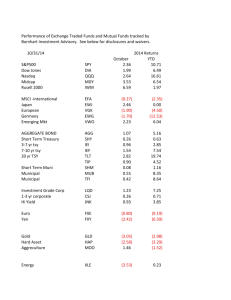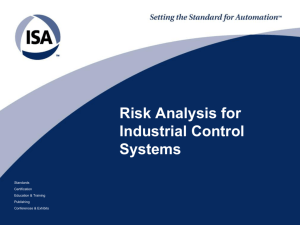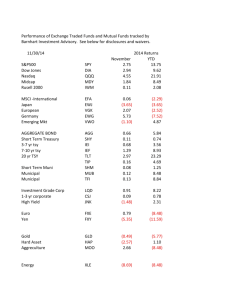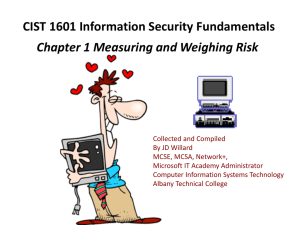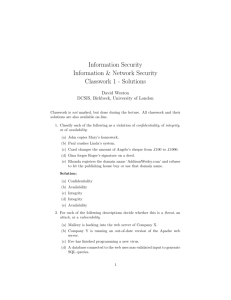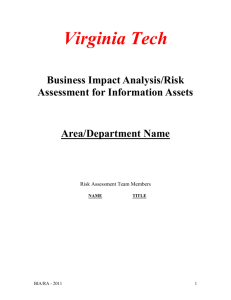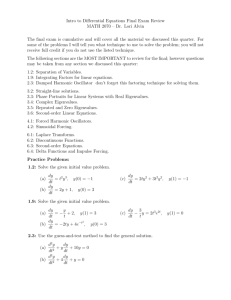Risk Management
advertisement
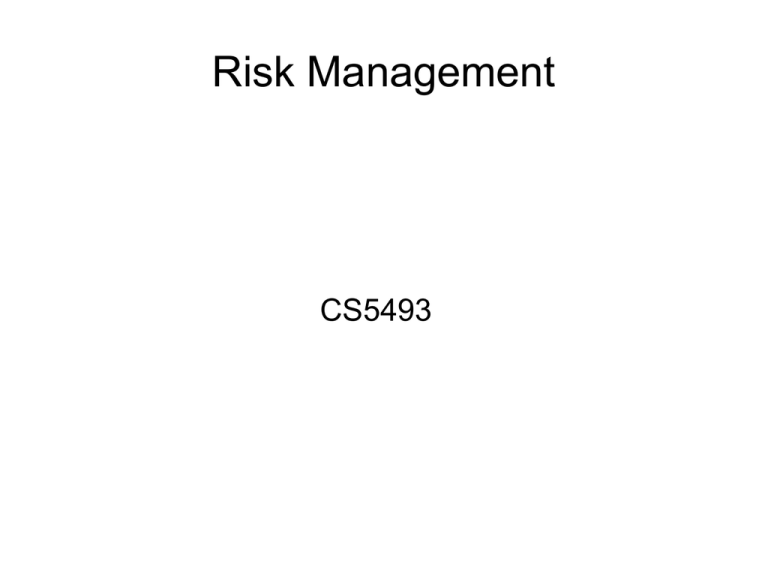
Risk Management CS5493 Risk Management The process of ● identifying, ● assessing, ● prioritizing, and ● mitigating risks Risk Management ● An ongoing process that has a life-cycle – (sustainability cycle) Risk Management ● Minimize the effects of negative risks ● Maximize the effects of positive risks Risk Management ● Asset – anything of value Risk Management ● threat – anything that can exploit, obtain, damage or destroy an asset via a vulnerability intentionally or accidentally. A threat is what you wish to protect against. Risk Management ● Vulnerability – weaknesses exploited by threats that compromise assets. A vulnerability is a weakness Define a Risk Equation ● Risk = Threats x Vulnerabilities – Threats = frequency of an adverse event – Vulnerability = the probability that a threat will succeed. – Risk = the risk probability Risk Management ● The exposure cost is the product of the riskprobability value times the loss (of the asset) in dollars. Cost = RiskProbability * AssetLoss Example (annual) ● ● ● Probability of a fire in the data center resulting in a loss: 0.75% Probability of the fire destroying all assets in the data center: 15% Risk Probability = .0075*.15 = .001125 Example (annual) ● ● Replacement value of the data center: $750,000. Estimated annual loss due to fire = $843.75 (risk probability * value of the asset) Risk Identification ● The process of determining the risks to assets. ● Create the “risk register” Risk Register ● Creation: – Brainstorming meeting to identify the risks – Surveys – Other events to collect information. Risk Register ● Content – A description of each identified risk – Probability of the risk event occurring – Steps to mitigate – Rank each risk in the register – Describe the impact if the risk-event actually occurs and include the cost. Risk Register ● Ranking risks – Limited budget will require dropping some perceived risks. – Concentrate on the most important issues. Risk Analysis ● Qualitative ● Quantitative Risk Analysis ● Qualitative – Risk classification ● ● ● – High Medium Low risk impact : how would it impact the overall business. Risk Analysis ● Quantitative – Use math Risk Analysis ● Quantitative – EF = Exposure Factor – SLE = Single Loss Expectancy ● SLE = Asset Value x EF – ARO = annual rate of occurrence – ALE = annual loss expectancy ● ALE = SLE x ARO Quantitative Risk Table Resource Risk Building Fire File Server disk crash Data theft Value EF SLE ARO ALE $700,000.00 0.6 $420,000.00 0.2 $84,000.00 $50,000.00 0.5 $25,000.00 0.2 $5,000.00 $200,000.00 0.9 $180,000.00 0.7 $126,000.00 Risk Response Planning ● Negative Risks ● Positive Risks Risk Response Planning ● Responses to negative risks – Eliminate – Transfer – Mitigate – Accept Negative Risk Response ● ● ● ● Eliminate – implies that the threat has been eliminated (probability of zero). Transfer – insurance is used to transfer risk Mitigate – reduce the probability of the event from occurring by taking some action. Accept – take no additional action. Risk Response Planning ● Response to positive risks – Exploit – Share – Enhance – Accept Positive Risk Response ● ● ● ● Exploit – S-A-P is packaged and sold. Share – finding a partner to purchase in bulk and capture a lower price. Enhance – meeting a deadline ahead of schedule and collecting a bonus Accept – take no action BIA ● Business Impact Analysis, BIA – A formal analysis separating an organization's functions into critical and non-critical categories BIA RPO ● RPO - Recovery Point Objective, – Determine the amount of asset loss that is acceptable BIA RTO ● RTO - Recovery Time Objective, – The maximum allowable time to recover from asset loss. Risk Management • BIA- Business Impact Analysis • BCP- Business Continuity Plan • DRP - Disaster Recovery Plan BIA ● Business Impact Analysis, – Classifying business functions and activities into critical or non-critical categories. – Determining the prerequisites to support each function/activity. – Determine the maximum amount of time each function/activity can be unavailable. BCP ● BCP – Business Continuity Plan – A response plan to interruptions of critical functions ● ● An interruption is an event that lasts for a short period and while it will result in measurable loss, is not fatal. Creation of an IT intrusion response team DRP ● DRP – Disaster Recovery Plan – A plan for responding to losses and interruptions critical to the sustainability of the enterprise. – Creation of an IT disaster response team DRP ● DRP – Disaster Recovery Plan – Fire – Flood – Hurricane – Tornado – Earthquake DRP Requirements ● Contact list of critical personnel ● Complete inventory of physical assets ● Inventory of IT software applications for critical business functions. ● Data/system backups ● Alternate or redundant facility planning
